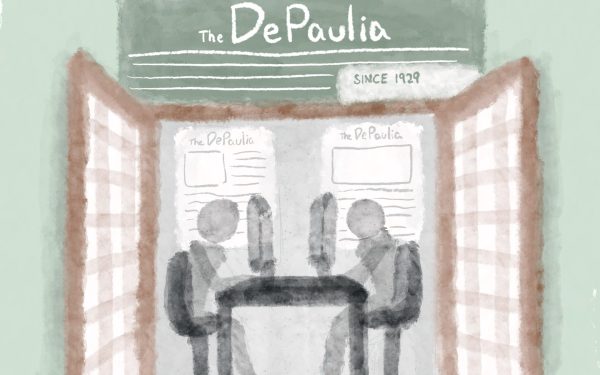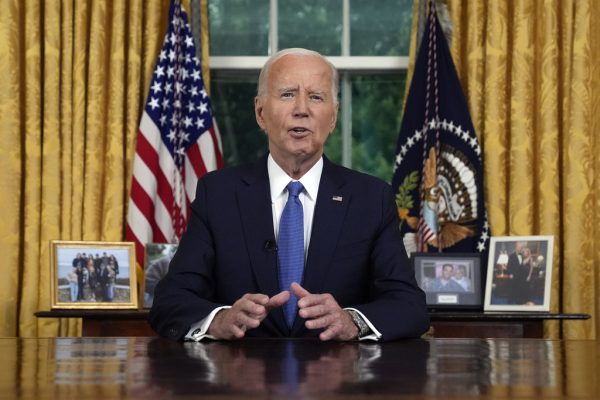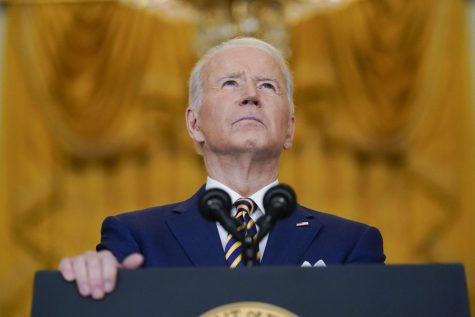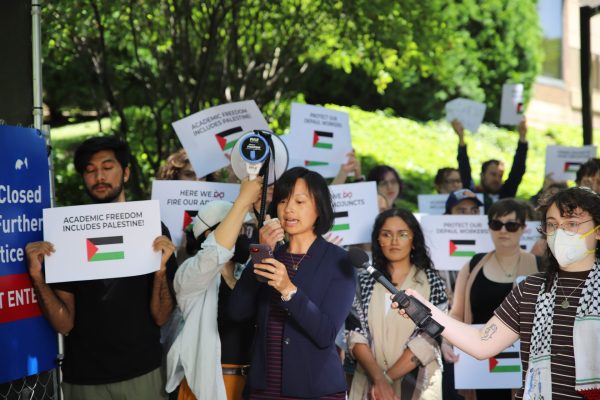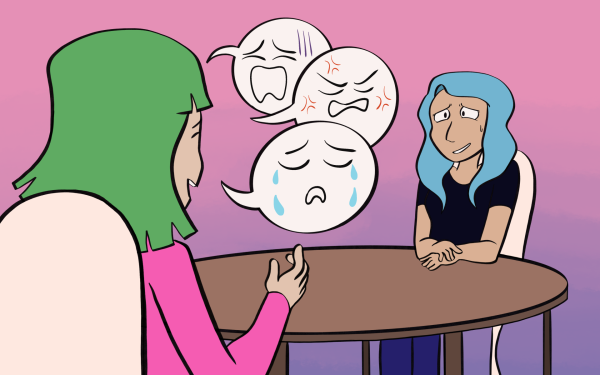Op-ed: The small window for student representation at DePaul

Protestors march east on Fullerton Ave.
With COVID-19 sending the DePaul community into self-isolation, students have taken our needs and those of our community and demanded they be met. From the fight to treat laid-off Chartwells dining workers with human dignity, to the call for the university to end its relationship with Lodge 7 of the Fraternal Order of Police and the pleas for tuition relief as the pandemic looks to enter its sixth month, students have been loud and persistent.
But despite our appeals, DePaul’s administration brushes off nearly all of them, leaving us looking through a tiny window as decisions are made, an experience all too familiar today.
As it stands, student input on the university’s decisions is, in practice, nonexistent, and for most students, untangling the bureaucratic mess of DePaul, finding where the power lies and knowing the reality of it, is often half the battle. Two of the most important university bodies are the Strategic Resource Allocation Committee (SRAC), which is ultimately charged by the Board of Trustees to create the university’s budget, and the Joint Council, the largest body of power outside of the Board of Trustees. Through SRAC, which, per a message from Interim Provost Salma Ghanem to faculty on Newsline, reconvened to consider budget adjustments due to COVID-19, Chartwells workers could be paid. Likewise, through SRAC, students could have their tuition reduced. And through Joint Council, the relationship with the FOP could be severed. It should need little more illustration to show that these groups matter.
But when it comes to students in these groups, the picture is rather drab. On SRAC, students hold one of nine seats, and on Joint Council, an even bleaker figure — one of 31.
Even though we compose the largest group in the DePaul community, our seat at the table is the smallest. And this is to ignore the power of the Board of Trustees, an eclectic group of elite banking, real estate and finance executives, university presidents and lawyers, which can override decisions made by both SRAC and Joint Council. Here, students really are looking in as decisions are being made. But before we proceed, let’s linger on the Board of Trustees a little longer, and fully extrapolate the power dynamic.
Those sitting on the Board control not just the affairs of the university, nor just a vast amount of money and resources, but our futures. Their grasp of the corporate world, with the mesh of connections between the trustees and the immensity of influence they hold by virtue of their positions, is a stranglehold.
The Board of Trustees doesn’t exist to make sure that the DePaul community thrives as it claims to, but to make sure we are ready to spend the rest of our lives in a pacified servitude to them.
The concept of the university turned factory, where students are pulled, bent, pounded, pressed into shape and spit out, fit for use by capital interests was predicted by the late and former president of the University of California, Clark Kerr, which he called the ‘multiversity.’ Unsurprisingly for Kerr, the FBI blacklisted him, and withheld nomination to President Lyndon Johnson’s Cabinet as a result.
DePaul University’s recent actions seem to reinforce that Kerr’s prediction rings true: students are the raw materials to be made into workers, designed by and for business interests.
Our situation seems dire, and it is. As I mentioned, students, through the Student Government Association (SGA) hold one of the nine seats on SRAC. This power relationship is codified in a university policy, and as if 2020 could not be more eventful, the policy governing SRAC and the budget drafting process is up for its mandatory three-year review process this year. The armor surrounding SRAC is impenetrable, but this year, there’s a small chink. This review will be conducted by yet another bureaucratic appendage, the Policy Review Group, of which, yet again, students hold a singular seat on, accompanied by a cohort of less prominent administrators, as well as staff and faculty representatives.
Within SGA, a group of us are committed to getting more student representation on SRAC, through the Policy Review Group, but we understand it will be a tough fight, and moreover, that our window of time to seize a victory for students is as small as that with which we must watch decisions be made. With that said though, it is important to recognize that it is not an impossible task, by any stretch.
SGA, under the leadership of former president Casey Clemmons, succeeded in expanding the total student representation on university groups from 13 to 41 in a single year. The task is possible, and as SGA, we plan to accomplish it.
DePaul administration, if you are listening, know that students are tired of being written off. We are tired of waiting for the time to be right. We are tired of excuses. We are tired of watching. We are tired of seeing the Vincentian mission be applied only when you say it does. And know that you have our numbers. Student organizers and activists have been active in calling you, emailing you and advocating for what we believe in. Maybe return a few of those.
As just one of the over 20,000 students at DePaul, know that I need more from you, and the rest need even more. Our money is turned into that budget, the same one that pays your salaries. At minimum, we deserve to be listened to, not just heard and dismissed. As students, we are owed more than the small window we have now, and as a member of the Student Government Association, I will fight alongside my fellow students to make sure it happens.



